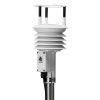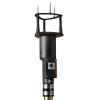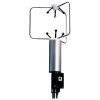YOUNG ResponseONE Ultrasonic Anemometer
Features
- Optional internal compass to for mobile applications
- Serial output formats include SDI-12, NMEA, and ASCII text
- Wiring connections are made in a convenient weatherproof junction box
- Free ground shipping
- Expedited repair and warranty service
- Lifetime technical support
- More
Overview
The YOUNG Model 915000 and 910000 ResponseONE Ultrasonic Anemometer is ideal for general meteorological applications requiring accurate and reliable measurements.
Durable
The IP66 rated construction enables reliable operation in severe environments. Each sensor is fully wind tunnel tested and calibrated to provide accurate wind measurement over a wide operating range. Standard serial output formats include SDI-12, NMEA, and ASCII text. Output may be continuous or polled to conserve power. Standard RS-232 or RS-485 serial formats enable direct integration with YOUNG displays, marine NMEA systems, data loggers or other compatible serial devices. The sensor mounts on a standard 1-inch IPS pipe. A mounting orientation ring is included that engages with the base of the sensor to retain orientation when the sensor is removed for maintenance. Terminations are made in a junction box at the base of the sensor by small clamp-style connectors (no special connectors are required).
Internal Compass
The YOUNG Model 91500 ResponseONE Ultrasonic Anemometer includes an internal compass to provide orientation for wind direction, making it ideal for mobile or portable applications.
In The News
Save our Bogs! Culture, Conservation and Climate Action in Ireland’s Peatlands
Characterized by long-term accumulation under waterlogged conditions, peatlands exist on every continent and account for 3-4% of the global land surface . Small but mighty, these often overlooked wetland environments are estimated to hold as much as one-third of the world's organic carbon in their soil—twice the amount found in the entirety of the Earth's forest biomass. While healthy peatlands can trap and store carbon, regulate water, and provide important habitats for rare species, human alteration has disturbed peatland carbon and nitrogen cycles on a global scale. Approximately 12% of the world’s peatlands have been drained and degraded through conversion for agriculture, forestry, infrastructure development, and other uses.
Read MoreSargassum Surge: How Seaweed is Transforming our Oceans and Coastal Ecosystems
Until recently, Sargassum –a free-floating seaweed–was distributed throughout the Sargasso Sea , the north Caribbean Sea, and the Gulf of Mexico. But in the space of a decade, this seaweed has, as one scientist remarks , “Gone from a nonfactor to the source of a terrible crisis.” Driven by climate change, anomalous North Atlantic Oscillation in 2009-2010 and a glut of anthropogenic pollutants, sargassum has proliferated. Seasonally recurrent mats as deep as 7m now bloom in the “Great Atlantic Sargassum Belt” (GASB), which covers areas of the Atlantic from West Africa to the Caribbean Sea and Gulf of Mexico. Every year, millions of tons wash up along the shores of more than 30 countries . Dr.
Read MoreGreat Lakes Research Center: Designing Targeted Monitoring Solutions
According to the National Oceanic and Atmospheric Administration ( NOAA ), the Great Lakes have more miles of coastline than the contiguous Atlantic and Pacific coasts combined and contain 20 percent of the world's freshwater, making it a critical region to protect and conserve. Continuous monitoring and data-informed resource management are key components of managing waters in the region. Hayden Henderson, a research engineer with the Great Lakes Research Center (GLRC), designs and deploys monitoring platforms throughout the Great Lakes. With a background in environmental engineering, Henderson enjoyed the challenge of creating systems and making them work to obtain difficult, remote measurements.
Read More














